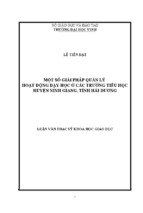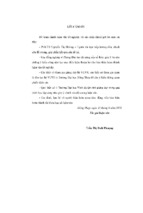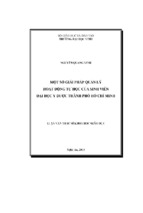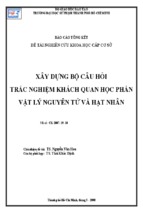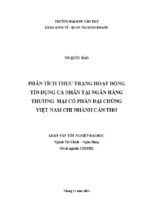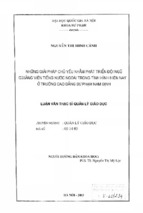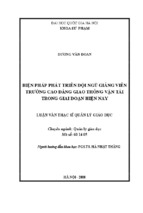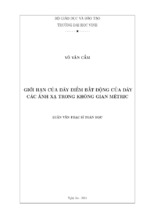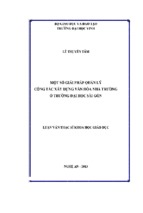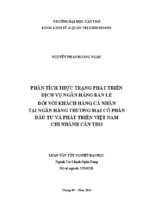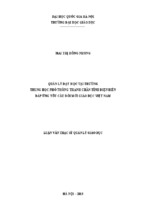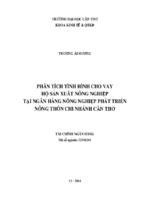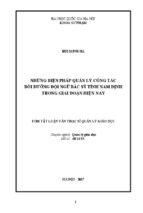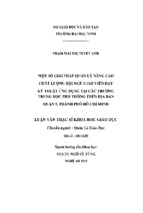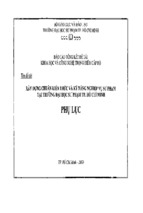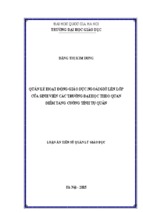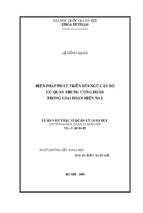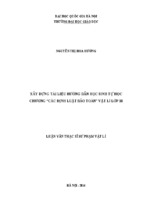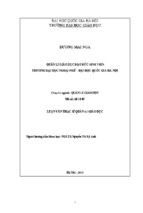With the trend of globalization, teaching English to young learners has been
attracting a lot of attention all around the world, including Vietnam. In teaching
English, teaching vocabulary is an indispensable activity. It is not only about
helping students remember the meaning of words but also about helping them to
hear words, pronounce words correctly and apply words in communication. So
finding the effective teaching methods is an urgent demand of all teachers,
especially Primary English teachers. Total Physical Response (TPR), developed by
James Asher in 1960s, is a language teaching method which encourages people to
combine language learning with physical actions. This study explores the
application of TPR method to vocabulary teaching in a primary school by carrying
out the quasi-experimental method with two groups of students from Quang Son
primary school in Tam Diep city, Ninh Binh Province. In the process of the
experiment, one group of students was taught by the TPR teaching method, another
group of students was taught by the common traditional teaching method. The data
from this experiment shows that "TPR" group had a better command of the
vocabulary retention and physical actions could encourage students to enjoy
learning English. Through the above results, this study is hoped to be a useful
resource for teachers to understand as well as to apply the TPR method in the class
and help students to learn effectively.
THAI NGUYEN UNIVERSITY
SCHOOL OF FOREIGN LANGUAGES
BUI THI DIEU HUONG
USING TOTAL PHYSICAL RESPONSE
TO ENHANCE VOCABULARY RETENTION
FOR THE THIRD GRADE STUDENTS
(Sử dụng phương pháp phản xạ toàn thân (TPR) để tăng cường
khả năng ghi nhớ từ vựng cho học sinh lớp 3)
M.A. THESIS
Field: English Linguistics
Code: 8220201
THAI NGUYEN - 2020
THAI NGUYEN UNIVERSITY
SCHOOL OF FOREIGN LANGUAGES
BUI THI DIEU HUONG
USING TOTAL PHYSICAL RESPONSE
TO ENHANCE VOCABULARY RETENTION
FOR THE THIRD GRADE STUDENTS
(Sử dụng phương pháp phản xạ toàn thân (TPR) để tăng cường
khả năng ghi nhớ từ vựng cho học sinh lớp 3)
M.A. THESIS
(APPLICATION ORIENTATION)
Field: English Linguistics
Code: 8220201
Supervisor: Nguyen Thi Quyet, Ph.D.
THAI NGUYEN - 2020
DECLARATION
I certify that I myself write this thesis entitled “Using Total Physical
Response (TPR) to enhance vocabulary retention for the third grade students"
to fulfil the requirement for Degree Master of Art at School of Foreign Languages,
Thai Nguyen University. All the literature I used is properly quoted and listed in the
Bibliography.
Thai Nguyen, 2020
Approved by Supervisor
Student
Nguyen Thi Quyet, Ph.D.
Bui Thi Dieu Huong
i
ACKNOWLEDGEMENTS
At the completion of this thesis, I would like to express my sincere thanks to
my supervisor, Nguyen Thi Quyet, Ph.D. for her valuable suggestions, instructions
and encouragements.
I would like to express my great gratitude to my colleagues as well as my
third grade students at Quang Son Primary School for their support in the lessons,
the tests and the questionnaire.
Finally, I would like to express my deep appreciation to my family for all the
wholehearted support I received to finish this thesis.
ii
ABSTRACT
With the trend of globalization, teaching English to young learners has been
attracting a lot of attention all around the world, including Vietnam. In teaching
English, teaching vocabulary is an indispensable activity. It is not only about
helping students remember the meaning of words but also about helping them to
hear words, pronounce words correctly and apply words in communication. So
finding the effective teaching methods is an urgent demand of all teachers,
especially Primary English teachers. Total Physical Response (TPR), developed by
James Asher in 1960s, is a language teaching method which encourages people to
combine language learning with physical actions. This study explores the
application of TPR method to vocabulary teaching in a primary school by carrying
out the quasi-experimental method with two groups of students from Quang Son
primary school in Tam Diep city, Ninh Binh Province. In the process of the
experiment, one group of students was taught by the TPR teaching method, another
group of students was taught by the common traditional teaching method. The data
from this experiment shows that "TPR" group had a better command of the
vocabulary retention and physical actions could encourage students to enjoy
learning English. Through the above results, this study is hoped to be a useful
resource for teachers to understand as well as to apply the TPR method in the class
and help students to learn effectively.
iii
TABLE OF CONTENTS
DECLARATION ......................................................................................................... i
ACKNOWLEDGEMENTS ........................................................................................ii
ABSTRACT .............................................................................................................. iii
TABLE OF CONTENTS ........................................................................................... iv
LISTS OF TABLES AND FIGURES ......................................................................vii
LIST OF ABBREVIATIONS ................................................................................. viii
CHAPTER I: INTRODUCTION ............................................................................ 1
1.1. Rationale ........................................................................................................... 1
1.2 Aims of the study............................................................................................... 3
1.3 Research questions ............................................................................................ 3
1.4 Scope of the study ............................................................................................. 3
1.5 Structure of the study......................................................................................... 3
CHAPTER II: THEORETICAL BACKGROUND............................................... 5
2.1. Vocabulary ....................................................................................................... 5
2.1.1 Definition of vocabulary ............................................................................. 5
2.1.2 The role of vocabulary in language learning .............................................. 6
2.1.3 Types of vocabulary ................................................................................... 6
2.1.4 Vocabulary retention .................................................................................. 8
2.2. Teaching vocabulary for primary students ....................................................... 9
2.2.1 Characteristics of primary students ............................................................ 9
2.2.2 Principles of teaching vocabulary to primary students ............................. 10
2.2.3 Techniques of teaching vocabulary to primary students .......................... 11
2.3 Total Physical Response .................................................................................. 12
2.3.1 Definition of TPR ..................................................................................... 12
2.3.2 Objectives of TPR..................................................................................... 13
2.3.3 Principles of applying TPR in language teaching .................................... 15
2.3.4 The Role of the Teacher and Learners in TPR ......................................... 16
2.3.5 Application of TPR in language classroom .............................................. 17
iv
2.3.6 Advantages of using TPR in teaching vocabulary.................................... 21
2.3.7 Previous studies on using TPR in teaching vocabulary ............................ 22
CHAPTER III: METHODOLOGY ...................................................................... 25
3.1 Methods of research ........................................................................................ 25
3.2 Participants ...................................................................................................... 26
3.3. Data collection ................................................................................................ 26
3.3.1 Data collection instruments ...................................................................... 27
3.3.2 Data collection procedure ......................................................................... 30
3.3.3 Data analysis ............................................................................................. 33
3.4. Feasibility of the research method.................................................................. 34
CHAPTER IV: FINDINGS AND DISCUSSION ................................................. 35
4.1 Tests analysis ................................................................................................... 35
4.1.1 The Results of Data Analysis of the Pretest ............................................. 35
4.1.2 The Results of Data Analysis of the Post-test 1 ....................................... 37
4.1.3 The Results of Data Analysis of the Post-test 2 ....................................... 40
4.2 Questionnaire result analysis ........................................................................... 43
4.3 Discussion........................................................................................................ 45
CHAPTER V: CONCLUSIONS ............................................................................ 48
5. 1. Summary........................................................................................................ 48
5.2. Implications .................................................................................................... 49
5.3. Limitations of the study .................................................................................. 49
5.4. Suggestions ..................................................................................................... 49
5.4.1. For the english teachers ........................................................................... 49
5.4.2. For the students ........................................................................................ 50
5.4.3 For the other researchers ........................................................................... 50
REFERENCES ........................................................................................................ 52
APPENDIX A: VOCABULARY TEST 1 (PRETEST) ............................................. I
APPENDIX B: VOCABULARY TEST 2 (POSTTEST 1) ...................................... III
APPENDIX C: VOCABULARY TEST 3 (POSTTEST 2) ....................................... V
APPENDIX D: LESSON PLAN FOR THEME 1: ................................................. VII
v
APPENDIX E: LESSON PLAN FOR THEME 2: ...................................................IX
APPENDIX F: LESSON PLAN FOR THEME 3: ...................................................XI
APPENDIX G: LESSON PLAN FOR THEME 4 ................................................. XIII
APPENDIX H: THE STUDENTS' SCORES AND THE REALIBILITY
COEFFICIENT OF THE TEST ITEMS IN PRE-TEST ........................................ XV
APPENDIX I: THE STUDENTS' SCORES AND THE REALIBILITY
COEFFICIENT OF THE TEST ITEMS IN POST-TEST 1 ............................... XVIII
APPENDIX J: THE STUDENTS' SCORES AND THE REALIBILITY
COEFFICIENT OF THE TEST ITEMS IN POST-TEST 2 ..................................XXI
APPENDIX K: QUESTIONNAIRE FOR STUDENTS (Vietnamese) .............. XXIV
APPENDIX L: QUESTIONNAIRE FOR STUDENTS (English) ...................... XXV
vi
LISTS OF TABLES AND FIGURES
Tables
Table 3.1:
Test description ................................................................................... 28
Table 3.2:
Questionnaire description .................................................................... 30
Table 3.3:
The procedure of training .................................................................... 32
Table 3.4:
Conversion of percentage range .......................................................... 34
Table 4.1:
Students‘ scores of the control group in the pre-test ........................... 35
Table 4.2:
Students‘ scores of the experimental group in the pre-test ................. 36
Table 4.3:
Students‘ scores of the control group in post-test 1 ............................ 37
Table 4.4:
Students‘ scores of the experimental group in post-test 1................... 38
Table 4.5:
Students‘ scores of the control group in post-test 2 ............................ 40
Table 4.6:
Students‘ scores of the experimental group in post-test 2................... 41
Table 4.7:
Mean scores of two groups in vocabulary tests .................................. 42
Table 4.8:
Question 1 - Students‘ opinions about TPR English lessons .............. 44
Table 4.9:
Question 2 - Students‘ opinions about TPR activities ........................ 44
Table 4.10:
Question 3 - Interest in learning English vocabulary through TPR
activities................................................................................................ 45
Figures
Figure 2.1:
Vocabulary forms .................................................................................. 7
Figure 2.2:
Atkinson and Shiffrin memory model (1968) ....................................... 8
Figure 3.1
Non Randomized Control Group Design ............................................ 25
Figure 3.2
Data collection procedure.................................................................... 30
Figure 4.1:
The comparison between scores in post-test 1 of control and
experimental group .............................................................................. 39
Figure 4.2:
Comparison between pre-test score and post-test 2 score of
experimental group .............................................................................. 43
vii
LIST OF ABBREVIATIONS
%
: Percent
TPR
: Total Physical Response
FL
: Foreign language
L2
: Second language
EFL
: English as a Foreign Language
CG
: Control Group
EG
: Experimental Group
viii
CHAPTER I
INTRODUCTION
In this chapter, the writer presents the rationale, aims, scopes and the
structure of this study.
1.1. Rationale
English is the language of international communication with official status in
at least 80 countries around the world (British Council, 2016) so studying English is
extremely important. Saleh (1997:12) argued, ―the success in mastering a language
is determined by the size of the vocabulary one has learned‖. Wilkins (1972:111)
said, ―Without grammar, very little can be conveyed; without vocabulary, nothing
can be conveyed.‖ That is the reason why vocabulary is one of the most important
elements of language. Many researchers believe that to build a language wall, the
vocabulary is "bricks" and grammar and sentence structures are "mortar circuits" to
bind the bricks that make up the language wall. Without vocabulary knowledge,
both language production and language comprehension would not be possible.
Therefore, the retention of vocabulary knowledge is one of the most important
prerequisites to master a new language and it can only be possible when teachers
apply effective teaching methods.
Since children are playful, hardly concentrate and lack self-controlling, they
can easily lose interest in learning without images. Thornbury (2002:23) adds ―The
learner needs not only to learn a lot of words, but to remember them.‖ Moreover,
teaching English for primary students is not the same as teaching English in
secondary or high schools. Primary students face lots of difficulties. According to
Brewster and friends (2002:81) children at this age are still in the process of
building their first language and the learning of vocabulary in second language is a
complex matter. They maybe have less motivation to learn English because their
attention is weak and lack of sustainability, easily dispersed by sounds and events
other than content of learning. So, it is a big challenge for the teacher to find a
proper method to improve the students' ability in comprehension and retention
vocabulary.
1
The key to stress-free learning is to tap into natural bio-program for language
development and thus to recapture the relaxed and pleasurable experiences that
accompany first language learning (Richards & Rodgers, 1986). Therefore, teachers
should create an interesting classroom atmosphere and put a particular effort on
more fully preparing materials and activities to get vocabulary instead of giving the
boring meanings or keeping explaining it in front of the class without considering
the children's characteristics and needs.
There are lots of effective teaching methods that can be applied in teaching
vocabulary. One of them is Total Physical Response. Total Physical Response
(TPR) is a teaching vocabulary method proposed by James Asher (1988). TPR is
built around the coordination of speech and action, it attempts to teach language
through physical activity (Richard and Rodgers, 2001:73). TPR makes learning
become enjoyable and less stressful because the children seem like playing and
moving all the time. This method is especially effective for young learners to
remember phrases and words well as their first vocabularies are usually easy to be
conveyed in action.
In Quang Son Primary School - a small school in a difficult mountainous
commune, English teaching program for students from grade 3 to grade 5 has been
implemented since 2015 in the spirit of Vietnam‘s National Foreign Language 2020
Project. However, the fact that students still face a lot of numerous difficulties in
pronouncing the words, how to write and spell, how to use grammatical patterns
correctly. Especially, most of them cannot retain knowledge for a long time. This
fact pushes up the necessity in applying some way which can help children
remember words better and TPR is a potential solution as it is psychologically
suitable for children.
Based on the explanation above, the writer is interested in conducting a
research entitled "Using Total Physical Response to enhance vocabulary retention
for the third grade students." The main purpose is to explore the effects of applying
TPR method in teaching and learning in order to enhance students‘ retention of
English vocabulary. Then this research would aim to propose the way that TPR can
2
be applied as a method to teaching and learning vocabulary to the third grade
students in Quang Son Primary School. The writer also hopes that this study would
be one of the references about teaching through TPR method.
1.2 Aims of the study
The aim of this study is to explore the impact of applying TPR method in
teaching and learning in order to enhance students‘ retention of English vocabulary.
To fulfill the aim, the following objectives are carried out for exploration:
- to investigate into how TPR can improve students' vocabulary.
- to identify the improvement of students by using TPR method.
- to give suggestions in applying TPR to help students enhance their
vocabulary retention.
1.3 Research questions
To make the tasks manageable, the above objectives are translated into the
following research questions:
1. How does TPR improve students' vocabulary?
2. To what extent does the use of TPR help students to retain vocabulary?
3. What suggestions should be given regarding the application of TPR in
enhancing students‘ vocabulary retention?
1.4 Scope of the study
Teaching English to children needs to focus on all skills. However, this study
only focuses on the influence of TPR method on the vocabulary retention of
students within the context of teaching and learning English as a compulsory
subject at Quang Son Primary School.
Due to the time limit, this research is conducted on only two classes with 60
third grade students at Quang Son Primary School in school year 2019 - 2020.
1.5 Structure of the study
This study is divided into five chapters. They are:
Chapter I - Introduction - provides the rationale for the study, aims of the
study, research questions, scope of the study and structure of the study.
3
Chapter II - Theoretical background - provides the theoretical background of
the study, namely basic knowledge about English vocabulary and vocabulary
learning; TPR method in generally and in teaching and learning vocabulary.
Chapter III - Methodology - describes the methods used for this study, data
collection instruments, data collection procedures and data analysis procedure.
Chapter IV - Finding and discussion - presents, analyzes and discusses the
results collected. In this chapter, the answer for the research question is found.
Chapter V - Conclusion - summarizes the main issues of this paper, giving
the limitations, pedagogical implications of the study and suggestions for further
studies.
4
CHAPTER II
THEORETICAL BACKGROUND
In this chapter, the writer gives general knowledge about vocabulary and
vocabulary learning; TPR method and several previous studies on using TPR in
teaching vocabulary.
2.1. Vocabulary
2.1.1 Definition of vocabulary
Vocabulary is obviously an extremely important element that requires
mastering when learning a language. It can be defined in many different ways.
According to Cambridge Advance Learner‘s Dictionary Online, vocabulary is:
a) all the new words that a person knows or uses;
b) all the words that in a particular language;
c) the words that people use when they are talking about a particular subject;
d) a lists of words with their meanings, especially in a book for learning a
foreign language.
There are also many other definitions of vocabulary proposed by experts.
Hornby (1994) stated that vocabulary is total number of words that makes up a
language. Hatch and Brown (1995) claimed that vocabulary is a list or set of words
for a particular language or a list or set of words that individual speakers of a
language might use. Brown (2001) viewed vocabulary items as a boring list of
words that must be defined and memorized by the student, lexical forms are seen in
their central role in contextualized and meaningful language. Richards (2002) added
that vocabulary is one of the most recognized components of language.
According to Kim and Kim (2012), ―vocabulary is the base of communication
in that language. Therefore, it is critical to try out various and different teaching
style that cheers students to acquire vocabulary easily without negative emotion
about it‖. Talking about vocabulary, McCarthy (1990: 140) also stated that without
words to express a wider range of meanings, communication in an L2 just cannot
happen in any meaningful way. Students' vocabulary knowledge is a building
5
process that occurs over time as they make connections to other words, learn
examples and non-examples of the word and related words, and use the word
accurately within the context of the sentence (Snow, Griffin, & Burns, 2005).
Based on the statements above, it can be assumed that vocabulary is the total
number of words - a basic component of language proficiency which has a form or
expression and contains of aspects, they are meaning, use of word, form
(pronunciation and spelling).
2.1.2 The role of vocabulary in language learning
According to Wilkins (1972), without grammar very little can be conveyed,
without vocabulary nothing can be conveyed. Thus, it can be said that vocabulary is
the heart of every language because without sufficient vocabulary we cannot
understand others or express our own ideas.
In learning a foreign language, vocabulary plays an extremely important role.
Mastering vocabulary is essential for successful second language use. As Huckin
(1995) stated, second language readers rely heavily on vocabulary knowledge and
the lack of that knowledge is the main and the largest obstacle for L2 readers to
overcome. For example, when we come up with any meanings or concepts, we need
a stock of vocabulary to choose and express suitably. Dunlap and Weisman (2007)
asserted, vocabulary development is essential for English learners‘ academic
success. There is a strong relationship between vocabulary knowledge and academic
achievement.
From the statements above, it can be concluded that vocabulary is a very
important part of a language. The more words you know, the better you will be able
to master the language.
2.1.3 Types of vocabulary
Elfrieda and Michael (2005) stated that vocabulary can be presented in
different types according to different purposes.
According to Lehrer (2000), vocabulary is defined as the knowledge of word
meaning so it can be classified into the oral and written vocabulary.
6
- Oral vocabulary includes all the words we use while speaking (speaking
vocabulary) and all the words we hear and understand while listening (listening
vocabulary).
- Written vocabulary consists of all the words that we understand when we read
text (reading vocabulary) and all the words that we can retrieve while writing what we
want to express (writing vocabulary).
Besides, Jo Ann Aeborsold and Mary Lee Field (1977) divided vocabulary into
two main types: active and passive vocabulary.
- Active vocabulary is the words that we understand and use in speaking or
writing. It is called as the productive side of language for:
• The use of right word in right place.
• The spontaneous recall of words.
• Grammatical accuracy: use of correct tenses, inflections and word order.
• In speech, fluency and ability to reproduce correct sounds, pronunciation,
intonation, rhythm etc.
- Passive vocabulary, on the other hand, refers to words that we understand but
are not yet able to use. It is called as the receptive side of language for:
• A recognition of vocabulary in speech or writing.
• An acquaintance with major grammatical items or forms.
• The skill of stimulating rapidly the sense of large word groups.
As such, it can be summed up that vocabulary consists of several major types in
the diagram below:
Passive
(Receptive)
Reading
Listening
Oral
VOCABULARY
Speaking
Writing
Active
(Productive)
Figure 2.1: Vocabulary forms
7
Written
2.1.4 Vocabulary retention
Learning vocabulary is a complex task. According to Ellis (1995) it involves
various components: processing auditory and visual input, producing spoken and
written output, and knowing the syntactic and semantic relations between words.
Before being used to produce meaningful sentences, vocabulary has to be retained
in the learners' memory.
Retention is defined as a memory storage process. Atkinson and Shiffrin
(1968) described this process through different stages. First, a new word would be
detected by the sense organs and enters the sensory memory. Then, it is paid
attention to and transferred to short-term memory. Repetition of information causes
a new word to be transmitted to long-term memory. If maintenance rehearsal
(repetition) does not occur, the word is removed from short-term memory and lost.
Input
Sensory
memory
Short-term
memory
Attention
Long-term
memory
Forgetting
Figure 2.2: Atkinson and Shiffrin memory model (1968)
Thus, vocabulary retention can simply be understood as the ability to recall or
remember things after an interval of time. Vocabulary retention is an essential factor
affecting the success of vocabulary learning. ―In language teaching, retention of
what has been taught may depends on the quality of teaching, the interest of the
learners, or the meaningfulness of the materials‖ (Richards & Schmidt, 2002).
Therefore, in order to transfer information accurately from working-memory
to long-term memory, FL/L2 learners need to treat the information actively rather
than passively, and interact with the information in meaningful ways (Schmitt,
2000). FL/L2 learners also need to look for both relationships and differences
between the new information and other information that is already in long-term
memory, and link them together (Amiryousefi & Ketabi, 2011; Mayer, 2014). One
8
way to transfer the new lexical terms from the short-term memory to the long-term
memory is to build a connection through finding some elements ―in the mental
lexicon‖ (Amiryousefi & Ketabi, 2011, p. 179), and attach the new lexical item to
those elements (Schmitt, 2000).
Information transfer in the present research context referred to the transfer of
target words from L2 learners‘ short-term memory to their long-term memory.
Thus, learners required some vocabulary learning strategies to acquire new lexical
information and transfer them to memory for consolidation purposes.
2.2. Teaching vocabulary for primary students
2.2.1 Characteristics of primary students
Primary school students are those aged between six to ten years old. Their
characteristics and motivations are completely different from students at other
levels. In this stage of education, encouragement positively affects them a lot. It
requires that the teacher should have interesting teaching ways to attract children‘s
attention to the lesson and stimulate their learning progress.
In order to teach English successfully, above all, it is essential for the teachers
to identify learners‘ characteristics to choose appropriate methods and activities.
Most primary school students are:
- Energetic and physically active: they prefer to get up and move with
dynamic energy instead of sitting still for a long period. It means that their
concentration is associated with their actions and practical activities. What they can
interact directly will make them more focused and remember longer instead of the
monotony and the conscription.
- Spontaneous, active and receptive: they are willing to take part in activities
and speak out in English without feeling embarrassed. They also are good imitators
of language. They can repeat similarly the teacher, sing new songs, do variety
actions, play different roles although they may not know English very well or even
they don‘t know meaning of some words.
- Imaginative and creative: students at this age are so imaginative. They like to
join the role plays, interactive games, or perform activities that simulate familiar.
9
- Easily distracted and have short memory: primary school students‘ memory
is a typical example of sensory memory. Due to the activity of the first signaling
system in students this age predominates, the cerebral hemispherical shell is easy to
receive specific visual, color, and object signals. They remember and preserve
exactly the specific things, images and phenomena faster and better than long-term
definitions and explanations.
In short, it is very important to consider the characteristics of learners.
Teachers should rely on them to choose appropriate methods and activities to
achieve the best teaching results.
2.2.2 Principles of teaching vocabulary to primary students
According to Chomsky (1959), learning was innate, in the sense that every
child has an innate capability to learn a language. Meanwhile, Vygotsky (1986)
believed that language was central to the cognitive development of children, and it
was the support given by adults that helped children learn and develop. In
agreement with Vygotsky, Bruner (1983) stated that the instruction from adults is
like a scaffolding that helps children develop their thinking and learning process.
Besides, children learn about their world in different ways of different ages. They
may be characterized as visual, auditory or kinesthetic learners.
Lado (1964), An American expert on modern linguistics gave some principles
of language teaching, of which there are at least three principles that can be applied
in teaching vocabulary to the primary students. These principles are as follows:
Pattern as Habits
Young learners enjoy imitating and skilful in listening accurately and
mimicking what they have heard. Their language habits can be established by
practicing patterns day by day and expanding bit by bit.
According to Lado
(1964:51) to know the language is to use its pattern of construction. Understanding
or even verbalizing a pattern may help students learn it but will never take the place
of practicing the pattern through analogy; variation and transformation to establish
them as habits. For the third grade students - the beginner the language must be
started from the simplest one. For example:
10
- Xem thêm -

